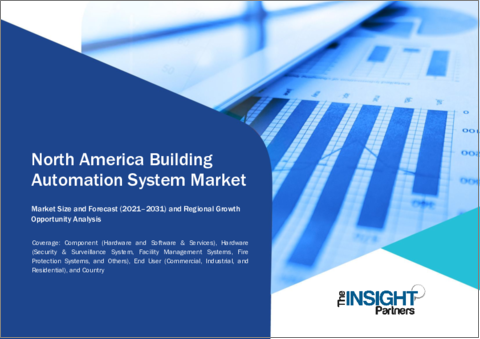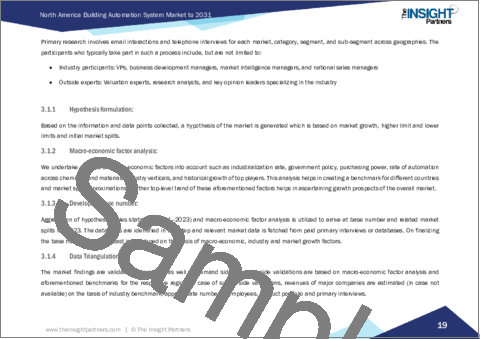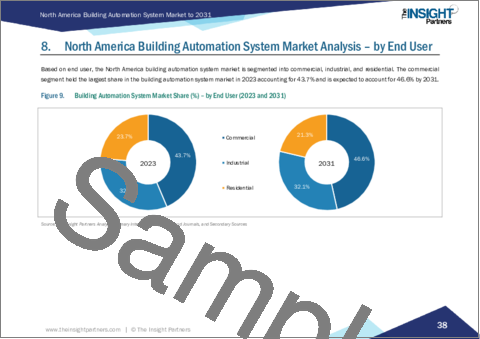|
|
市場調査レポート
商品コード
1666278
北米のビルディングオートメーションシステム市場:2031年までの予測 - 地域別分析 - コンポーネント別、エンドユーザー別North America Building Automation System Market Forecast to 2031 - Regional Analysis - by Component and End User (Commercial, Industrial, and Residential) |
||||||
|
|||||||
| 北米のビルディングオートメーションシステム市場:2031年までの予測 - 地域別分析 - コンポーネント別、エンドユーザー別 |
|
出版日: 2025年01月13日
発行: The Insight Partners
ページ情報: 英文 133 Pages
納期: 即納可能
|
全表示
- 概要
- 図表
- 目次
北米のビルディングオートメーションシステム市場は、2023年に269億4,114万米ドルとなり、2031年までには566億791万米ドルに達すると予測され、2023年から2031年までのCAGRは9.7%と推定されます。
ビル居住者の快適性、安全性、セキュリティ強化に対するニーズの高まりが北米のビルディングオートメーションシステム市場を後押し
ビルディングオートメーションシステム(BAS)は、最先端の機器や技術を導入することで、ビルのセキュリティシステムを改善します。ビルの居住者により良いセキュリティを提供するだけでなく、資産、企業資源、財産、ITデータを保護します。物的損害や盗難の防止に加え、従業員の不正行為に対するセキュリティも提供します。また、ガス火災やガス漏れなどの安全上の問題を検知し、そのリスクを抑えるために適切な措置を取るようにプログラムすることも可能です。さらに、エレベーターアクセスコントロールシステムは、ビル内の特定のフロアやエリアへのアクセスをブロックするのに役立ちます。また、このシステムは、セキュリティ侵害を防御し、一時的なネットワーク・トラフィックを施設内に誘導することができます。入退室管理では、許可された担当者のみにアクセスが許可されます。さらに、建物内で発生するすべての活動は、入退室管理ソフトウェアによって記録・保存されます。ビルの室内環境品質(IEQ)と快適性は、ビルディングオートメーションシステムを利用することで改善できます。これらのシステムは、ビル全体の温度と湿度レベルを一定に保ち、快適に保つように設計することができます。ビル内の空気が清潔で汚染されていないことを保証するために、特にオフィスビルや学校ビルのような稼働率の高い構造物では、BASを使用して空気の質を監視・管理しています。このように、ビル居住者の快適性、安全性、セキュリティの向上に対するニーズの高まりが、ビルディングオートメーション市場を牽引しています。
北米のビルディングオートメーションシステム市場概要
北米のビルディングオートメーションシステム市場の成長は、Honeywell International Inc.、Johnson Control International PLC、Siemens AG、Schneider Electric SE、Oracle Corporationなどの主要企業の存在に起因します。ビルディングオートメーションシステムは、ビル全体の資産を制御・監視するための様々な利点を提供するため、市場は急成長を遂げています。Johnson Controlsは4つの主要セグメントで事業を展開しており、業務用HVAC、照明、セキュリティ、保護システムを統一プラットフォーム上にシームレスに統合し、通信と情報交換を強化するビルディングオートメーションシステムを提供しています。TracerSC+プラットフォームを中心としたTraneのビルディングオートメーションシステムは、センサーや機器制御から完全な企業管理まで、包括的な製品群を網羅しています。組織の拡張要件に適応可能で、標準的でオープンなBACnetプロトコルを利用して、TraneとTrane以外のデバイスを効果的に相互接続・統合します。
北米のビルディングオートメーションシステム市場の収益と2031年までの予測(金額)
北米のビルディングオートメーションシステム市場のセグメンテーション
北米のビルディングオートメーションシステム市場は、コンポーネント、エンドユーザー、国に分類されます。
コンポーネントに基づいて、北米のビルディングオートメーションシステム市場は、ハードウェアとソフトウェア・サービスに二分されます。2023年の市場シェアはハードウェアセグメントが大きくなりました。さらに、ハードウェアセグメントは、セキュリティ・監視システム、施設管理システム、防火システム、その他にサブセグメント化されます。
エンドユーザー別では、北米のビルディングオートメーションシステム市場は、商業、産業、住宅にセグメント化されます。2023年には商業セグメントが最大の市場シェアを占めました。
国別では、北米のビルディングオートメーションシステム市場は米国、カナダ、メキシコに区分されます。2023年の北米のビルディングオートメーションシステム市場シェアは米国が独占しました。
ABB Ltd、Mitsubishi Electric Corp、Bosch Sicherheitssysteme GmbH、Honeywell international Inc、Schneider Electric SE、Siemens AG、Johnson Controls International Plc、Carrier Global Corp、Lutron Electronics Co., Inc、Trane Technologies Plcなどが北米のビルディングオートメーションシステム市場で事業を展開する主要企業です。
目次
第1章 イントロダクション
第2章 エグゼクティブサマリー
- 主要洞察
- 市場の魅力
第3章 調査手法
- 2次調査
- 1次調査
- 仮説の策定
- マクロ経済要因分析
- 基礎数値の開発
- データの三角測量
- 国レベルのデータ
第4章 北米のビルディングオートメーションシステム市場情勢
- エコシステム分析
- バリューチェーンのベンダー一覧
第5章 北米のビルディングオートメーションシステム市場:主要市場力学
- 市場促進要因
- ビル居住者の快適性、安全性、セキュリティ強化に対するニーズの高まり
- ワイヤレスセンサーネットワーク技術とワイヤレスプロトコルのビルディングオートメーションシステムへの統合
- 市場抑制要因
- 熟練した専門家の不足
- 高い設置・導入コスト
- 市場機会
- 持続可能なビルディングオートメーションソリューションへのニーズの高まり
- スマートシティプロジェクトへの取り組みの高まり
- 今後の動向
- コンシューマーIoT、IPベースデバイス、SaaS、その他の技術開発
- 促進要因と抑制要因の影響
第6章 ビルディングオートメーションシステム市場:北米分析
- ビルディングオートメーションシステム市場の収益、2021年~2031年
- ビルディングオートメーションシステム市場の予測分析
第7章 北米のビルディングオートメーションシステム市場分析:コンポーネント別
- ハードウェア
- ソフトウェア・サービス
第8章 北米のビルディングオートメーションシステム市場分析:エンドユーザー別
- 商業
- 産業
- 住宅
第9章 北米のビルディングオートメーションシステム市場:国別分析
- 北米
- 米国
- カナダ
- メキシコ
第10章 競合情勢
- 企業のポジショニングと集中度
- ヒートマップ分析:主要企業別
第11章 業界情勢
- 市場イニシアティブ
- 製品開発
- 合併と買収
第12章 企業プロファイル
- ABB Ltd
- Mitsubishi Electric Corp
- Bosch Sicherheitssysteme GmbH
- Honeywell International Inc
- Schneider Electric SE
- Siemens AG
- Johnson Controls International Plc
- Carrier Global Corp
- Lutron Electronics Co., Inc
- Trane Technologies Plc
第13章 付録
List Of Tables
- Table 1. North America Building Automation System Market Segmentation
- Table 2. List of Vendors
- Table 3. Building Automation System Market - Revenue and Forecast to 2031 (US$ Million)
- Table 4. Building Automation System Market - Revenue and Forecast to 2031 (US$ Million) - by Component
- Table 5. Building Automation System Market - Revenue and Forecast to 2031 (US$ Million) - by Hardware
- Table 6. Building Automation System Market - Revenue and Forecast to 2031 (US$ Million) - by End User
- Table 7. North America: Building Automation System Market - Revenue and Forecast to 2031 (US$ Million) - by Country
- Table 8. United States: Building Automation System Market - Revenue and Forecast to 2031 (US$ Million) - by Component
- Table 9. United States: Building Automation System Market - Revenue and Forecast to 2031 (US$ Million) - by Hardware
- Table 10. United States: Building Automation System Market - Revenue and Forecast to 2031 (US$ Million) - by End User
- Table 11. Canada: Building Automation System Market - Revenue and Forecast to 2031 (US$ Million) - by Component
- Table 12. Canada: Building Automation System Market - Revenue and Forecast to 2031 (US$ Million) - by Hardware
- Table 13. Canada: Building Automation System Market - Revenue and Forecast to 2031 (US$ Million) - by End User
- Table 14. Mexico: Building Automation System Market - Revenue and Forecast to 2031 (US$ Million) - by Component
- Table 15. Mexico: Building Automation System Market - Revenue and Forecast to 2031 (US$ Million) - by Hardware
- Table 16. Mexico: Building Automation System Market - Revenue and Forecast to 2031 (US$ Million) - by End User
- Table 17. Heat Map Analysis by Key Players
- Table 18. List of Abbreviation
List Of Figures
- Figure 1. North America Building Automation System Market Segmentation, by Country
- Figure 2. Ecosystem Analysis
- Figure 3. Building Automation System Market - Key Market Dynamics
- Figure 4. Impact Analysis of Drivers and Restraints
- Figure 5. Building Automation System Market Revenue (US$ Million), 2021-2031
- Figure 6. Building Automation System Market Share (%) - by Component (2023 and 2031)
- Figure 7. Hardware: Building Automation System Market - Revenue and Forecast to 2031 (US$ Million)
- Figure 8. Software & Services: Building Automation System Market - Revenue and Forecast to 2031 (US$ Million)
- Figure 9. Building Automation System Market Share (%) - by End User (2023 and 2031)
- Figure 10. Commercial: Building Automation System Market - Revenue and Forecast to 2031 (US$ Million)
- Figure 11. Industrial: Building Automation System Market - Revenue and Forecast to 2031 (US$ Million)
- Figure 12. Residential: Building Automation System Market - Revenue and Forecast to 2031 (US$ Million)
- Figure 13. North America Building Automation System Market, by Key Country - Revenue (2023) (US$ Million)
- Figure 14. North America: Building Automation System Market Breakdown, by Key Countries, 2023 and 2031 (%)
- Figure 15. United States: Building Automation System Market - Revenue and Forecast to 2031 (US$ Million)
- Figure 16. Canada: Building Automation System Market - Revenue and Forecast to 2031 (US$ Million)
- Figure 17. Mexico: Building Automation System Market - Revenue and Forecast to 2031 (US$ Million)
- Figure 18. Company Positioning & Concentration
The North America building automation system market was valued at US$ 26,941.14 million in 2023 and is expected to reach US$ 56,607.91 million by 2031; it is estimated to register a CAGR of 9.7% from 2023 to 2031.
Rise in Need for Enhanced Comfort, Safety, and Security Among Building Occupants Fuels North America Building Automation System Market
Building automation systems (BAS) improve a building's security system with the implementation of cutting-edge instruments and techniques. It provides better security to the building's occupants as well as protects assets, corporate resources, property, and IT data. In addition to preventing property damage and theft, the system also provides security against employee fraud. The system can also be programmed to detect possible safety issues, such as gas fires or leaks, and take appropriate action to limit these risks. Further, the elevator access control system helps block access to select floors and areas within the building that are deemed restricted by the management staff. Also, the system guards against security breaches and allows temporary network traffic to be directed within the facility. Only authorized personnel are granted access in access control management. Furthermore, every activity occurring within the building is recorded and stored by access control software. A building's indoor environmental quality (IEQ) and comfort can both be improved by using building automation systems. These systems can be designed to keep the temperature and humidity levels consistent and comfortable across the building. To guarantee that the air in a building is clean and uncontaminated, BAS is used to monitor and manage the air quality, especially in structures with large occupancy rates, such as office and school buildings. Thus, the rising need for enhanced comfort, safety, and security among building occupants drives the building automation market.
North America Building Automation System Market Overview
The North America building automation system market growth is attributed to the presence of key players such as Honeywell International Inc., Johnson Control International PLC, Siemens AG, Schneider Electric SE, and Oracle Corporation. The market witness's rapid growth as building automation systems offers a range of benefits to control and monitor building-wide assets. Johnson Controls operates across four key segments, delivering building automation systems that enable the seamless integration of commercial HVAC, lighting, security, and protection systems on a unified platform to enhance communication and information exchange. Trane's building automation system, centered around the Tracer SC+ platform, encompasses a comprehensive range of products, from sensors and equipment controls to complete enterprise management. It is adaptable to expansion requirements of organization and utilizes the standard, open BACnet protocol to interconnect and integrate Trane and non-Trane devices effectively.
North America Building Automation System Market Revenue and Forecast to 2031 (US$ Million)
North America Building Automation System Market Segmentation
The North America building automation system market is categorized into component, end user, and country.
Based on component, the North America building automation system market is bifurcated into hardware and software & services. The hardware segment held a larger market share in 2023. Furthermore, the hardware segment is sub segmented into security & surveillance system, facility management systems, fire protection systems, and others.
In terms of end user, the North America building automation system market is segmented into commercial, industrial, and residential. The commercial segment held the largest market share in 2023.
By country, the North America building automation system market is segmented into the US, Canada, and Mexico. The US dominated the North America building automation system market share in 2023.
ABB Ltd; Mitsubishi Electric Corp; Bosch Sicherheitssysteme GmbH; Honeywell international Inc; Schneider Electric SE; Siemens AG; Johnson Controls International Plc; Carrier Global Corp; Lutron Electronics Co., Inc; and Trane Technologies Plc are some of the leading companies operating in the North America building automation system market.
Table Of Contents
1. Introduction
- 1.1 The Insight Partners Research Report Guidance
- 1.2 Market Segmentation
2. Executive Summary
- 2.1 Key Insights
- 2.2 Market Attractiveness
3. Research Methodology
- 1.1 Secondary Research
- 1.2 Primary Research
- 3.1.1 Hypothesis formulation:
- 3.1.2 Macro-economic factor analysis:
- 3.1.3 Developing base number:
- 3.1.4 Data Triangulation:
- 3.1.5 Country level data:
4. North America Building Automation System Market Landscape
- 4.1 Overview
- 4.2 Ecosystem Analysis
- 4.2.1 List of Vendors in the Value Chain
5. North America Building Automation System Market - Key Market Dynamics
- 5.1 Market Drivers
- 5.1.1 Rise in Need for Enhanced Comfort, Safety, and Security Among Building Occupants
- 5.1.2 Integration of Wireless Sensor Network Technology and Wireless Protocols with Building Automation Systems
- 5.2 Market Restraints
- 5.2.1 Lack of Skilled Professionals
- 5.2.2 High Installation and Implementation Cost
- 5.3 Market Opportunities
- 5.3.1 Growing Need for Sustainable Building Automation Solutions
- 5.3.2 Rising Initiatives in Smart City Projects
- 5.4 Future Trends
- 5.4.1 Consumer IoT, IP-based Devices, SaaS, and Other Technological Developments
- 5.5 Impact of Drivers and Restraints:
6. Building Automation System Market - North America Analysis
- 6.1 Building Automation System Market Revenue (US$ Million), 2021-2031
- 6.2 Building Automation System Market Forecast Analysis
7. North America Building Automation System Market Analysis - by Component
- 7.1 Hardware
- 7.1.1 Overview
- 7.1.2 Hardware: Building Automation System Market - Revenue and Forecast to 2031 (US$ Million)
- 7.2 Software & Services
- 7.2.1 Overview
- 7.2.2 Software & Services: Building Automation System Market - Revenue and Forecast to 2031 (US$ Million)
8. North America Building Automation System Market Analysis - by End User
- 8.1 Commercial
- 8.1.1 Overview
- 8.1.2 Commercial: Building Automation System Market - Revenue and Forecast to 2031 (US$ Million)
- 8.2 Industrial
- 8.2.1 Overview
- 8.2.2 Industrial: Building Automation System Market - Revenue and Forecast to 2031 (US$ Million)
- 8.3 Residential
- 8.3.1 Overview
- 8.3.2 Residential: Building Automation System Market - Revenue and Forecast to 2031 (US$ Million)
9. North America Building Automation System Market - Country Analysis
- 9.1 North America Building Automation System Market Overview
- 9.1.1 North America: Building Automation System Market Breakdown 2023 and 2031 (%)- by Country
- 9.1.1.1 North America: Building Automation System Market - Revenue and Forecast Analysis - by Country
- 9.1.1.2 United States: Building Automation System Market - Revenue and Forecast to 2031 (US$ Million)
- 9.1.1.2.1 United States: Building Automation System Market Revenue and Forecast to 2031 (US$ Million), by Component
- 9.1.1.2.2 United States: Building Automation System Market - Revenue and Forecast Analysis, by Hardware
- 9.1.1.2.3 United States: Building Automation System Market - Revenue and Forecast Analysis, by End User
- 9.1.1.3 Canada: Building Automation System Market - Revenue and Forecast to 2031 (US$ Million)
- 9.1.1.3.1 Canada: Building Automation System Market - Revenue and Forecast Analysis, by Component
- 9.1.1.3.2 Canada: Building Automation System Market - Revenue and Forecast Analysis, by Hardware
- 9.1.1.3.3 Canada: Building Automation System Market - Revenue and Forecast Analysis, by End User
- 9.1.1.4 Mexico: Building Automation System Market - Revenue and Forecast to 2031 (US$ Million)
- 9.1.1.4.1 Mexico: Building Automation System Market - Revenue and Forecast Analysis, by Component
- 9.1.1.4.2 Mexico: Building Automation System Market - Revenue and Forecast Analysis, by Hardware
- 9.1.1.4.3 Mexico: Building Automation System Market - Revenue and Forecast Analysis, by End User
- 9.1.1 North America: Building Automation System Market Breakdown 2023 and 2031 (%)- by Country
10. Competitive Landscape
- 10.1 Company Positioning & Concentration
- 10.2 Heat Map Analysis by Key Players
11. Industry Landscape
- 11.1 Overview
- 11.2 Market Initiative
- 11.3 Product Development
- 11.4 Mergers & Acquisitions
12. Company Profiles
- 12.1 ABB Ltd
- 12.1.1 Key Facts
- 12.1.2 Business Description
- 12.1.3 Products and Services
- 12.1.4 Financial Overview
- 12.1.5 SWOT Analysis
- 12.1.6 Key Developments
- 12.2 Mitsubishi Electric Corp
- 12.2.1 Key Facts
- 12.2.2 Business Description
- 12.2.3 Products and Services
- 12.2.4 Financial Overview
- 12.2.5 SWOT Analysis
- 12.2.6 Key Developments
- 12.3 Bosch Sicherheitssysteme GmbH
- 12.3.1 Key Facts
- 12.3.2 Business Description
- 12.3.3 Products and Services
- 12.3.4 Financial Overview
- 12.3.5 SWOT Analysis
- 12.3.6 Key Developments
- 12.4 Honeywell International Inc
- 12.4.1 Key Facts
- 12.4.2 Business Description
- 12.4.3 Products and Services
- 12.4.4 Financial Overview
- 12.4.5 SWOT Analysis
- 12.4.6 Key Developments
- 12.5 Schneider Electric SE
- 12.5.1 Key Facts
- 12.5.2 Business Description
- 12.5.3 Products and Services
- 12.5.4 Financial Overview
- 12.5.5 SWOT Analysis
- 12.5.6 Key Developments
- 12.6 Siemens AG
- 12.6.1 Key Facts
- 12.6.2 Business Description
- 12.6.3 Products and Services
- 12.6.4 Financial Overview
- 12.6.5 SWOT Analysis
- 12.6.6 Key Developments
- 12.7 Johnson Controls International Plc
- 12.7.1 Key Facts
- 12.7.2 Business Description
- 12.7.3 Products and Services
- 12.7.4 Financial Overview
- 12.7.5 SWOT Analysis
- 12.7.6 Key Developments
- 12.8 Carrier Global Corp
- 12.8.1 Key Facts
- 12.8.2 Business Description
- 12.8.3 Products and Services
- 12.8.4 Financial Overview
- 12.8.5 SWOT Analysis
- 12.8.6 Key Developments
- 12.9 Lutron Electronics Co., Inc
- 12.9.1 Key Facts
- 12.9.2 Business Description
- 12.9.3 Products and Services
- 12.9.4 Financial Overview
- 12.9.5 SWOT Analysis
- 12.9.6 Key Developments
- 12.10 Trane Technologies Plc
- 12.10.1 Key Facts
- 12.10.2 Business Description
- 12.10.3 Products and Services
- 12.10.4 Financial Overview
- 12.10.5 SWOT Analysis
- 12.10.6 Key Developments
13. Appendix
- 13.1 Word Index
- 13.2 About The Insight Partners





